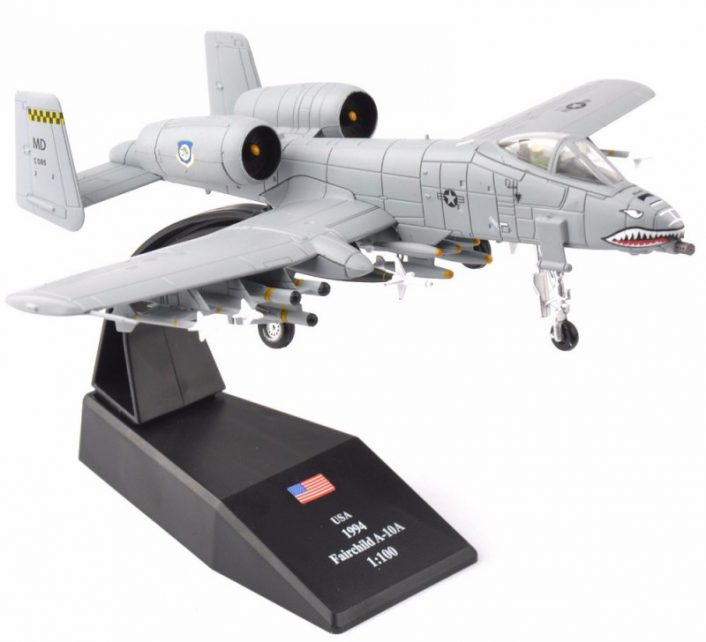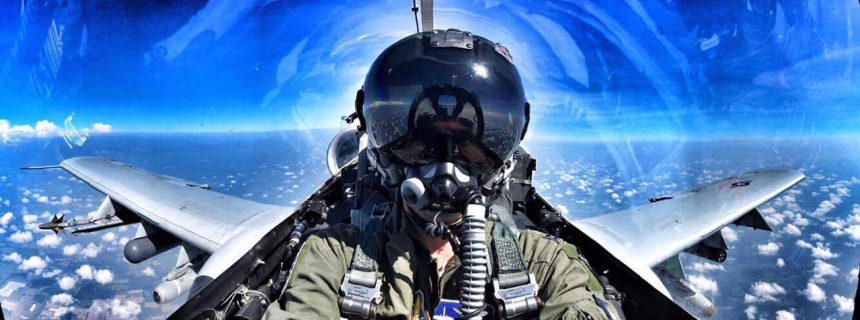A-10 Thunderbolt II Pilots Speak About The Warthog They Fly Over Afghanistan, Iraq, Korea, and Eastern Europe.
Dubbed Warthog, Hog or just Hawg, the A-10 Thunderbolt II, the “airplane built around the GAU-8 Avenger 30-mm hydraulically driven seven-barrel Gatling-type cannon” to fight the Soviet tanks in the European battlefields during the Cold War, is considered one of the most durable and lethal combat plane in the CAS (Close Air Support) mission.
We have discussed the current capabilities of the Warthog with two 74th Fighter Squadron “Flying Tigers” pilots from Moody Air Force Base, Georgia: Lt. Col. Bryan T. France, Former Commander, and Roberto “Pinna” Manzo, an Italian Air Force exchange pilot. Indeed, thanks to the Military Personnel Exchange Program, the U.S. Air Force has the opportunity to swap service members with an allied nation military: for this reason, whilst “Pinna”, from an AMX A-11A Ghibli experience with the 132° Gruppo (Squadron), flies with the 74th FS, U.S. Air Force Lt. Col. Joe “Slap” Goldsworthy, an A-10 Thunderbolt II pilot with more than 2,700 flight hours of experience, is assigned to the 132° Gruppo and flies the Ghibli (even in combat).
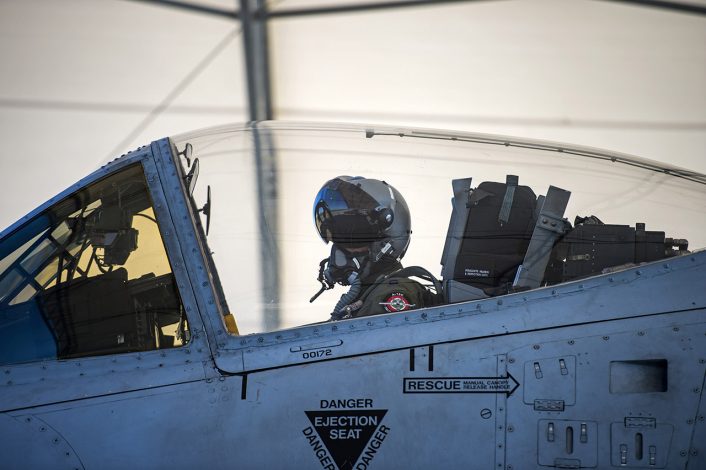
Lt. Col. Bryan T. France, Former Commander, 74th Fighter Squadron
Can you provide some details about the 74th FS?
The 74th Fighter Squadron is a combat-coded A-10C unit ready to support our operations with the best Close Air Support, Forward Air Control (Airborne), and Combat Search and Rescue on the planet.
Where have you been deployed with the A-10? Can you recall the most interesting missions you took part with the Hog?
I’ve had experiences around the world including Afghanistan, Iraq, Korea, and Eastern Europe. One of my most memorable experiences was landing A-10s on austere runways previously used by the Soviet Union 25 years ago. It took a true team effort including high-level coordination with our European allies. We were able to demonstrate a great capability that is unique to the Hog as a fighter aircraft.
Even though the aircraft has undertaken several upgrade programs since it was introduced in the 1970s, and the A-10C is much different from the “original” A-10A, the airframe has not changed too much in the last 40 years. Does this affect you has a pilot and commander of a Warthog squadron?
If I were to sit down to design a heavy attack platform, it would look just like the A-10. Our airframe was built to extend loiter times over the battlefield, deliver a substantial amount of ordnance, and survive significant battle damage. It does these things exceptionally well and, with the advent of the C-model precision guidance upgrades, integrates as well as any aircraft with data and sensor management.
What’s the typical payload to carry out the above-mentioned missions?
We have a large variety of weaponeering options available to us. The starting point is, of course, the mighty GAU-8 Avenger Gatling-type cannon. It’s a highly-accurate point-and-shoot weapon that grants our pilots superior firepower and flexibility in a close-combat ground fight. Additionally, we carry many other capable munitions including GPS-guided, laser-guided, and unguided bombs. Based on the flexibility this gives us, our payloads vary greatly from mission to mission.
30 mm gun aside, what’s the most flexible weapon you have on the A-10?
Second to the gun, I think the Maverick provides the most flexibility in weaponeering. We can employ it from medium or low altitudes against a large variety of target types. It’s a difficult weapon to master, but indispensable in a CAS fight.
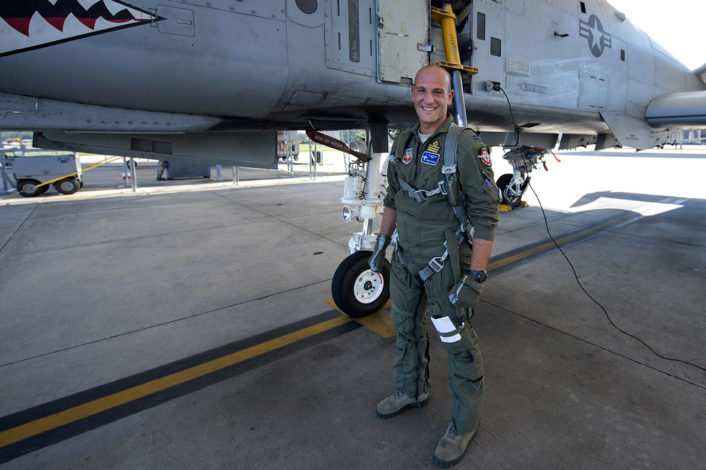
Italian Air Force exchange pilot Roberto “Pinna” Manzo
Tell us something about you. Who is “Pinna” and what about his experience?
I was born and raised in Ostia, near Rome.
I started my adventure in the Italian Air Force Academy, in 2003, with the Drago V course. Upon graduation, I attended the pilot courses with the Euro NATO Joint Jet Pilot Training (ENJJPT), at Sheppard, Texas, TX, between 2007 and 2008, flying the Cessna T-37B Tweet and Northrop T-38C Talon. Back in Italy, I was assigned to the A-11B AMX “Ghibli” and attended the first LIFT (Lead in Fighter Training) course with the 61º Stormo (Wing) at Lecce-Galatina airbase, in 2009, flying the MB-339CD and then the OCU (Operational Conversion Unit) course, with the 32º Stormo, at Amendola, on the AMX and AMX-T, between 2010 and 2011.
Once I arrived to my unit, the 51º Stormo, based at Istrana in northeastern Italy, I was assigned to the glorious 132º Gruppo (Squadron) FBR (Fighter Bomber Reconnaissance) “C. E. Buscaglia,” flying the “Ghibli” until my recent departure for the United States.
In addition to my personal and professional growth, during my time with the 132º I also earned my callsign, “Pinna” (Italian for “Fin”), which I’ve carried for several years now.
How did you get the opportunity to become an exchange pilot with the U.S. Air Force A-10?
The possibility of flying the legendary A-10 emerged in 2009 as a consequence of a bilateral agreement between the Italian and the U.S. Air Force. Several factors contribute in selecting the pilot destined to the Hog, including the flight experience, the achieved qualifications and currencies and, of course, the fluency with the English language (as no specific training is foreseen to improve with it before leaving for the U.S.). Although I already had a significant experience in the Close Air Support role with the AMX, I started to focus even more on this kind of mission once I learned that I would be assigned to the A-10. “Ponch”, my ItAF predecessor as an exchange pilot on the A-10 was extremely helpful during my transition from the AMX to the Warthog: he managed my induction in the American “system,” that is no easy task considered that there is very little time before things start to get serious.
Do you like the Warthog? If so, why?
The A-10C is an amazing aircraft: reliable, durable and lethal. It is a one of a kind combat plane: every single part of the Warthog is designed for Close Air Support. It is simple to handle and “forgiving”; its flight envelope makes it extremely maneuverable at low speeds and able to turn in tight spaces: this means it can circle over restricted areas and provide better support to the troops on the ground. Obviously, it’s not too fast but speed is not a mandatory feature when your main need is to remain “on station” as long as possible.
Everything in the airplane is duplicated, so as to make it as durable as possible: there are two tails, two hydraulic systems, two engines which are positioned on the outer side of the fuselage so as to minimize the risk of fire in case one of the two turbofan engines is hit. What’s more, the pilot sits in a titanium aircraft armor, referred to as a “bathtub,” which protects the cockpit from rounds fired from below.
Whilst externally the aircraft is almost identical, the avionics of the current A-10C has virtually nothing to do with the old “Hawg” that became particularly famous as the “Tank-buster” during the first Gulf War 25 years. The aircraft features an advanced data link system, HOTAS (Hands On Throttle And Stick) commands, three radios, a latest generation Targeting Pod, and also a sophisticated HMCS (Helmet Mounted Cueing System), that alongside the rest of the aircraft’s sensors, allows the pilot to effectively employ the weapon in a matter of seconds.
What are the main differences between the A-10 and the AMX? What part of your experience with the 132° Gruppo in Italy has been important with the Thunderbolt?
The A-10C and the AMX are much different aircraft. Both share a certain ease in handling, and it is no secret that the pilots of both aircraft would appreciate a bit more thrust from the engine. Furthermore, the Warthog is more maneuverable at low speeds while the AMX, with its aerodynamic design, is faster than the A-10. There are some differences in terms of missions flown by the two aircraft, though: throughout the years, an AMX pilot learns to fly several different mission profiles, spanning from reconnaissance to light attack, from CSAR (Combat SAR) to Close Air Support; the U.S. Air Force squadrons equipped with the A-10C, focus in these last two missions. My time with the 132° Gruppo, especially the tour in Afghanistan as a member of the Task Group Black Cats, has been extremely important in developing those skills required to keep up with colleagues who excel in CAS and CSAR execution.
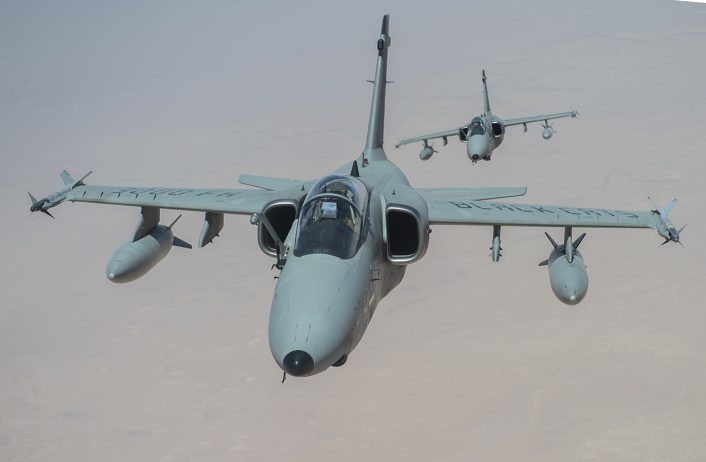
Any particular experience you’ve lived with the “Flying Tigers” you want to share with The Aviationist’s readers?
At the beginning of 2016 I’ve also had the chance to take part in a deployment to Europe as part of the 74th Expeditionary Fighter Squadron. It was impressive to see in what conditions the A-10C was able to operate: in Estonia, every morning, a dedicated team had to defrost the aircraft; then we taxied between pile-ups of snow surrounding the taxiways! In Bulgaria we had the opportunity to conduct air-to-air training with the MiG-29 and to fly at low altitude through the mountains before reaching the firing range; I was also fortune to participate in a CSAR training where we have managed to integrate Puma helicopters and Su-25 attack planes… something you don’t see every day!
In Germany, I had the pleasure of flying a CAS mission during which I was assigned an Italian JTAC: I still remember his surprise hearing an Italian voice coming from an American A-10.
I think the most complicated exercises are those in which we simulate the “contact” between friendly troops and the enemy on the ground: learning how to safely use the weapons in such [TIC – Troops In Contact] situations is as complex as vital, and requires extremely accurate planning on the ground and fine execution in flight…
